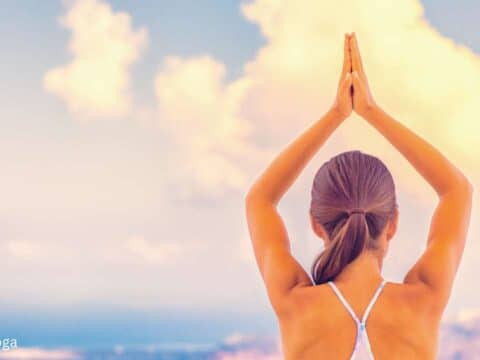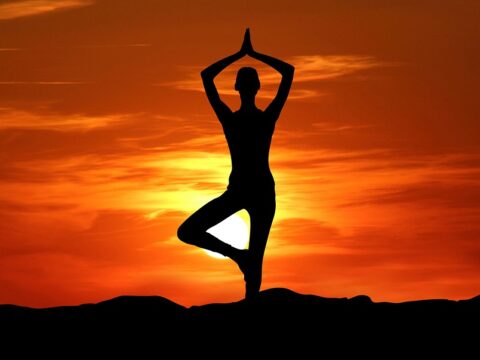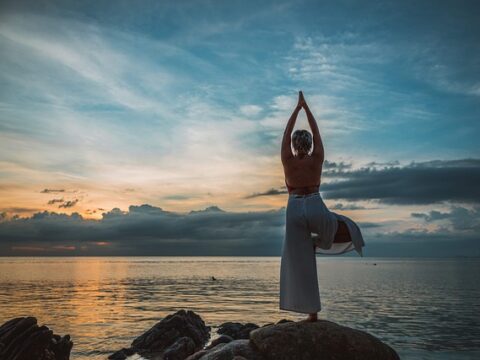On the curse side, flexibility can be a leading cause of unintentional stretching and joint overuse, which often result in strain, sprains, and other soft-tissue injuries. Flexibility is both a blessing and a curse for yoga. On the one hand, it increases the range of motion and joint health, preventing back pain, repetitive-use damage, and sports injuries. On the other hand, flexibility can lead to unintentional stretching and joint overuse, resulting in strain, sprains, and other soft-tissue injuries.
Although yoga is frequently associated with increased flexibility, there are many additional benefits that are often overlooked. People who are already flexible should be cautious of progressing too quickly into more advanced poses, as they may lack the muscular strength and proper alignment necessary to avoid injury.
The misconception that people need to be naturally flexible to do yoga keeps a lot of people out of the yogasphere.
If you have tight hips, hamstrings, calves, shoulders, whatever, yoga is a great way to improve flexibility. You don’t need to be flexible to start practicing yoga, becoming more flexible is a result of doing yoga.
Podcast
WHY FLEXIBILITY IS SO IMPORTANT
Flexibility is an important part of physical fitness. Most people are aware of the importance of cardio and strength training, but flexibility is often not considered until pain or injury occurs. When this happens, the treatment frequently involves stretching tight muscles that are limiting range of motion and putting stress on vulnerable areas like the joints.
Aside from the physical benefits of increased flexibility, there are also mental benefits. Stretching and increased flexibility often lead to a sense of relief from stress by releasing tension in the body. When the body is relieved of tension, the mind often follows suit, leading to a reduction in stress, insomnia, and an increase in well-being.
HOW DOES YOGA HELP IMPROVE FLEXIBILITY?
Yoga is a stretching routine that is safe and effective because it emphasizes proper form and alignment. The duration and variety of stretches also allow for a greater range of motion and target both major and minor muscle groups. With yoga, you can increase your attention and awareness to create a more mindful practice.
The way each pose is done can help to prevent injury and get the most benefit from the pose. This may include using props to support tight areas as they begin to open up. Having an understanding of alignment when practicing yoga can help make sure you are not injuring one area of the body while trying to focus on another area. An experienced yoga teacher can help point out alignment issues, as well as using a yoga mat with alignment guides.
To pay attention means that you are fully aware of what you are doing and not just going through the motions. This helps you to be aware of your body and to know the difference between discomfort and pain. Only you can make that decision.
Remaining focus on the present moment is key to practicing yoga effectively. The physicality of yoga and the use of breath help to anchor us in the now and bring us back to the present moment again and again. This awareness is a valuable tool in managing stress and anxiety.
HOW LONG DOES IT TAKE TO BECOME MORE FLEXIBLE?
Why the hurry? Consistent practice of a wide range of yoga postures over time leads to positive results. The sooner you start, the sooner you’ll see improvement, but it’s hard to say how long it will take because it depends on starting level, other activities, type of yoga, physique, and other factors. Practicing yoga regularly leads to improved flexibility.
If you’re looking to work on your flexibility, yoga classes are a great option. You’ll get guidance from instructors on how to gradually improve your flexibility, as well as how to use props when needed. If you’re worried about being the least flexible person in the class, don’t be. No one will pay attention to that. And if they do, just switch to a different class.
Best yoga poses for flexibility
It takes more than one night to become a yogi, however there are many classes both online and in person that can help you create a consistent yoga practice to improve your flexibility. To begin, try Vinyasa, Hatha, or Yin yoga.
Although you may not be able to attend a yoga class in person, you can still ease into the practice by trying various poses at home. Below are some of our favorite moves that will help improve your flexibility.
Go at your own pace in your yoga practice. The benefits you feel from the poses are more important than moving through them quickly. Instead of worrying about how you look, focus on how the poses make your body feel.
Do the poses correctly to avoid injury and get the most benefit. Repeat the poses as often as you like, but stop if you feel any pain.
1. Intense Side Stretch (Parsvottanasana)
This poses stretches your spine, legs, and hips while improving your balance, posture, and digestion.
One of the most challenging yoga poses is the Intense Side Stretch Parsvotthanasana. It requires the practitioner to bend forward while extending the arms at the side. This pose is also known as the homage posture. To practice this asana, it is important to slow down and breathe deeply. It takes practice and patience to get the desired effect. The benefits of this posture are immense.
Parsvottanasanosana is a standing asymmetrical forward fold with a slight spinal flexion in the upper thoracic region. It is important to practice the pose correctly, or it can result in misalignment. If performed incorrectly, this pose can result in hyperextended knees and gripping hip flexors. The pelvic floor engages powerfully as it supports the base of the pyramid, while the quads, adductors, and calves work constantly to maintain stability and balance.
To perform the pose, you must first bend the front knee. Then, engage your core and rotate the thighs as needed. Remember to breathe deeply and slowly throughout the pose. This will increase the length of your muscles and allow you to perform twists without feeling fatigued. If you do this correctly, you will notice a great difference in your body’s flexibility and strength. Intense Side Stretch Parsvottanasana helps you learn the nuances of this posture.
Intense Side Stretch poses are beneficial for strengthening your body and mind. They improve your posture and correct drooping shoulders and round hips. They also help relieve menstrual cramps. As you bend forward, your abdominal region contracts, stimulating your reproductive organs and easing cramps. Achieving balance in this pose will keep you feeling refreshed and comfortable throughout the day.
2. Head to Knee (Janu Sirsasana)
When you first start practicing head to knee janu sirsasana, make sure your knees are bent and your torso is balanced. Then, bend forward using your pelvic muscles, connecting your pelvis to the earth. If you experience pain, stop the pose. The benefits of this posture extend beyond the physical. In addition to improving your physical and mental health, head to knee janu sirsasana requires consistent practice and lifestyle changes to achieve optimal results.
If your knees are stiff, try practicing with a wooden block underneath the bent knee. If you are suffering from stress-related headaches or migraines, place a crepe bandage over your eyes. Make sure that you can balance the stretch of your legs. In addition, try to keep your elbows out to maximize chest expansion and lift your torso to increase the stretch on both sides of your body.
This pose stimulates the internal organs, especially the liver and spleen. It also stimulates the fascia around the kidneys. Practicing head to knee janusirsasana on a regular basis will keep your back in tip-top shape and relieve any lower back pain you may be suffering from. The benefits of this posture are numerous. A few of the most obvious are the following:
Before practicing Head to Knee Janu Sirsamasana, you need to stretch the front part of your body. Inhale deeply while keeping your wrists on the mat, then lower the right leg to rest flat on the floor. Reach your fingertips upward toward the sky. Make sure not to round your spine during this as this may lead to injury. This pose should be performed by someone with sufficient flexibility.
3. Cat-Cow (Bitilasana Marjaryasana)
If you love the cat-and-cow pose, you’ve come to the right place. This combination pose brings a gentle flow between two poses that will help warm the body, open the spine, and gently stimulate the abdominal organs. If you have extra belly fat, this yoga pose is the perfect way to get rid of it. Try this pose for belly fat and see if you can lose those extra pounds.
While you’re in the Cat Pose, try to keep your neck and spine loose. This pose releases the tension in your neck and spine. Try to keep your wrists and knees under your shoulders, while your chin is drawn down. Remember to breathe deeply to avoid straining your neck. Once you have mastered this yogic asana, it’s time to learn the cow and cat variations.
If you don’t have a yoga mat, don’t worry: you can still practice the Cat-Cow pose by using a blanket to place under your knees. If you’re on hard surfaces, you can practice this posture by lying on your back. You can also sit on a chair and try this pose. If you’re not comfortable lying on your back, try sitting on your hands and knees.
The cat cow pose, also known as Cat-Cow, is an amazing way to stretch the lower spine and hips. It also helps open the chest and lungs. Practicing this yoga pose will help you avoid back pain as you age. This yoga posture will give you more flexibility in the spine and keep you healthy and strong. If you practice it regularly, it can also help you prevent back pain and strengthen your core.
4. Bow Pose (Dhanurasana)
Dhanurasana is a common back bending yoga asana. It is often performed for exercise purposes. Here are some tips to help you perform this pose. Before trying it, be sure to watch some videos and read a book. Then, you’ll be ready to dive into your practice! Hopefully, this article will help you learn the best way to perform Bow Pose Dhanurasana.
This poses opens the chest and biceps. It improves the flexibility of the spine, preventing back problems like slip discs and herniated discs. This poses is beneficial for those who experience back pain or other issues, including menstrual problems. It is also beneficial for pregnant women and those who suffer from back pain. In addition, it helps strengthen the abdomen and diaphragm, while also strengthening the chest and back muscles.
When practicing the bow pose, the strap can help you stay in the pose. To begin, place the strap under your shins. Hold both ends of the strap with your hands, keeping your knees and feet hip-width apart. As you bend your knees and flex your feet, you should feel your rib cage widening as you breathe in and exhale. This pose can be challenging to perform for beginners, but it’s a good way to build strength and flexibility in your back.
Before attempting Bow Pose Dhanurasana, you should warm up your spine first by doing lower back bends. Then, release your ankles and rock backward and forward. If you feel uncomfortable with this pose, you can use a folded blanket to cushion yourself with extra padding. In order to stay in the pose, you must be able to breathe deeply and properly. If you can’t do this, you shouldn’t attempt it.
5. Low Lunge (Anjaneyasana)
Ajaneyasana, also known as Crescent Moon Pose, Ashwa Sanchalanasana, and Low Lunge, is a back bending asana that is often used in yoga exercise. If you’ve never practiced this posture before, it is well worth a try. This pose will challenge your core and improve your breathing while strengthening your legs and back.
The goal in this backbend pose is to move into a full, supine position with the tailbone descending toward the floor. Start by extending the front leg, pressing the heel to the mat, and rotating the back knee toward the ground. As you rise, make sure to remain rooted in the floor and engage your back leg. Hold the pose for five to ten breaths.
The origin of the name Anjaneyasana can be traced back to an incident in Hindu mythology. The god Brahma brought Anjaneya back from the dead and bestowed the name Hanuman upon him. The name Hanuman comes from the Hindi word hanu, which means “sun”. The Anjaneyasana is a kneeling hip opener that stretches the gluteus muscles and the quadriceps.
The Anjaneyasana is particularly helpful for athletes, because it stretches several key muscles that contribute to peak athletic performance. It is especially effective for runners and people who play high-impact sports. Begin by placing your palms on a yoga mat, with your feet hip-width apart. Your right leg should extend past your ankle. Your back leg should be straight with knees bent, and the front foot should come to your shoulder.
6. Wide-Angle Seated Forward Bend (Upavistha Konasana)
Upavistha Konasan, also known as Upavia Kosana, is an exercise in modern yoga. In this pose, you sit upright with your legs wide apart. Gripping your toes, you then lean forward. It’s not as hard as it may sound. Here are some tips to do this yoga pose correctly.
Firstly, remember to keep your lower back neutral and exhale while drawing your chest to the floor. To perform this yoga posture, you should also ensure that you don’t round your upper back too much. Try to maintain extension in the low back while rounding your upper spine. Try this pose in both directions and do it on both sides. You will benefit from this pose more than you might think.
When practicing Wide-Angle Seated Forward Bend Upasana, ensure you practice early in the morning to avoid causing stomach distress. You should also be hydrated to help with digestion. If possible, practice this asana 6 hours after a meal. Pregnant women should also avoid performing this asana. Nevertheless, it can provide great benefits to the adductor muscles and the lower back.
In addition to opening the hips, this pose is beneficial for the digestive tract and the spinal cord. The posture also improves the flexibility of the hands and the spine. The abdominal organs and the small intestine are stimulated in this pose. When you practice Wide-Angle Seated Forward Bend Upavistha Konasana, you will feel more relaxed and more flexible.
7. Eye of the Needle Pose (Sucirandhrasana)
The Eye of the Needle Pose, also known as the Cat and Cow poses, is a powerful asana for the hips. This pose is beneficial for the hips, spine, and buttocks. It improves blood flow and mental clarity. Be sure to practice this yoga pose carefully, with a flat back and a strap around the right ankle.
The eye-shaped body of this supine yoga pose is an excellent way to improve your balance. This pose can relieve stiffness in the outer hips and lower back. It can also ease tension in the knees. When done correctly, this pose is a great way to relax before bed or before you go to sleep. The benefits of this posture are plentiful. The Eye of the Needle pose can improve hip flexibility and strength.
The name Sucirandhrasana comes from the Sanskrit language, “sucrum, loop, and needle.” This yoga posture targets the hips, lower back, and inner thighs. It is a perfect warm-up pose before other poses, such as King Pigeon Pose or Sugarcane Pose. In addition to warming up your body, Sucirandhrasana also makes a great finishing pose for a Vinyasa sequence.
If you need to practice Sucirandhrasana without a wall, you can prop yourself up on a folded blanket. The bottom leg should be placed against the wall. Instead of lifting the leg toward the chest, keep the knees lifted straight. Once you have mastered the eye of the needle pose, you can move on to the supine spinal twist.
8. Cow Face Pose (Gomukhasana)
Cow Face Pose (also known as “cow pose”) is a basic yoga asana. This pose opens the Heart Center, grounding the lower body and balancing the crown and root. The pose is similar to the spiritual path, as it aims to promote balance between the mind and body. This yoga pose has many benefits. Here are some tips for practicing Cow Face Pose. To improve your posture, try it out now!
This posture requires careful attention to body alignment. The length of the neck and back are especially important. Some students tend to lean their head to one side while performing Cow Face Pose, so it is a good idea to use a strap or blanket to lift the bones of the spine. If you have trouble performing the pose without pain, consider seeking the guidance of an experienced yoga instructor. This pose will also help open the sciatic nerve, so it is a good back opener and will reduce your pain.
Performing this yoga pose is a good choice after performing dramatic hip openers, like Folded Butterfly and Standing Forward Bend. It will help release negative emotions and refuel the body with positive energy. For a great cow face pose, sit in staff pose for at least 10 minutes before attempting it. This posture can be followed by other backbends and open twists. The benefits are numerous.
9. Plow Pose (Halasana)
The name of this yoga pose comes from the plow, a tool used in India for sowing crops. The same principle is used in this posture, which stretches the spine and back. When practiced regularly, this pose can help relieve belly fat. It’s important to drink plenty of water after this pose, as drinking water is an excellent way to flush toxins from the body. Plow Pose is a good way to get a healthy belly, as it stretches the back, neck, and spine.
Plow Pose is a therapeutic massage for the endocrine glands, which include the pituitary gland, thyroid, and adrenal gland. These glands affect every other organ in the body, and the plow pose stimulates all of them. You can practice this yoga pose a few minutes a day for the best results. And it’s cheap! The benefits are numerous! Here’s a look at a few of the benefits of practicing Plow Pose Halasana:
The plow pose is an excellent yoga exercise to relieve stress and fatigue. You’ll find that it stretches your spine and shoulders, as well as the back of your legs. The pose also helps to reduce fatigue and stress, which are common symptoms of everyday life. Remember to maintain a soft neck and refrain from turning your head away from your ears. It’s also important to practice this pose under the supervision of a qualified yoga teacher.
10. Downward-Facing Dog (Adho Mukha Svanasana)
Downward-Facing Dog Adha Mukha Svanasana is a basic yoga pose. This inversion is performed as part of a flowing series of asanas such as Surya Namaskar. It is also commonly used in modern yoga as an exercise. This post outlines some benefits of this pose. Continue reading to learn more about this pose and how to perform it.
The first thing to understand about Downward-Facing Dog is that it requires two opposite actions in the arms, one internal rotation of the upper arms and the other for the lower arms. To correct this issue, Marlene Henny explains the proper way to position your arms while in Downward Dog, including an easy trick to keep them parallel while in the pose.
This yoga pose can be challenging for beginning students. But as the benefits of Adho Mukha Svanasana are so vast that it may become your new favorite relaxation pose. Downward-Facing Dog improves circulation in the lymphatic and bloodstream, cleanses the body of old waste products, and strengthens the abdominal muscles. It’s also an excellent transition pose between yoga and standing, as it helps the neck and upper body.
Downward-Facing Dog (Adho Mukha Svanasan) is a variation of Navasana. It is similar to the inverted V-shape of the Navasana and helps build the hamstrings. Often performed before bedtime, it can help you fall asleep. If you’re tired, it is also helpful to stretch your legs and arms.
11. Garland Pose (Malasana)
If you’re looking for the steps for Garland Pose Malasana, this article can help you achieve it. We’ll discuss what this posture entails, how to practice it, and what to do if you have trouble. After all, there’s no need to be a pro in yoga to get the benefits of this pose. This is just a quick guide to getting started!
First, practice the proper form of Garland Pose. Make sure to place your elbows inside your knees, not on top of them. Then, try to separate the long spine from the knees. Make sure to avoid jerky movements when you are in this pose, and do not try to squeeze your body into a deeper squat than you are comfortable with. If you start to experience pain while performing the pose, back out.
Garland Pose is a deep squat in yoga. It stretches the groin, knees, and ankles. The pose promotes proper digestion and helps you relieve problems such as constipation. It also stimulates the pelvic floor muscles and helps with indigestion and other symptoms of menopause. Although Garland Pose is generally suitable for all levels of practice, people with knee and lower back pain should avoid it.
When performing this pose, you should be able to hold it in the extended position for about five breaths. If you’re feeling pain in the back, you can modify it by placing the back against a wall or table to help relieve the pain. This pose will also loosen your hips, which will help you during labor. If you’re pregnant, you should consult with your healthcare provider and exercise caution to avoid injury.




